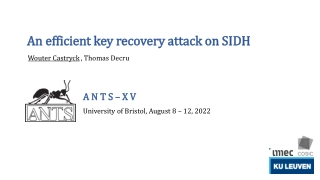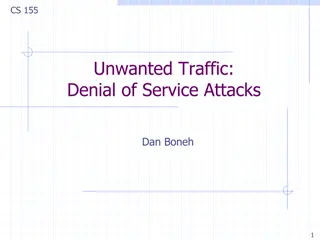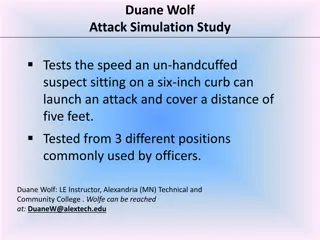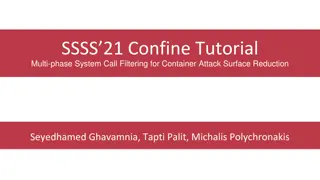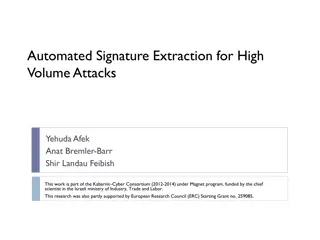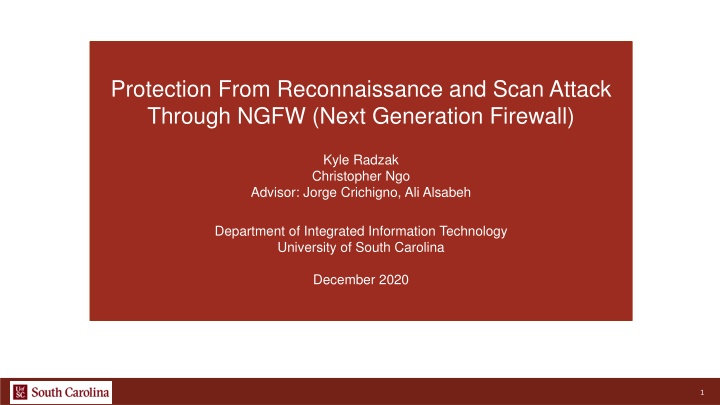
Protection from Reconnaissance and Scan Attacks Through NGFW
Explore the implementation of protection measures against reconnaissance and scan attacks using Next Generation Firewall (NGFW) technology. Learn how zone protection and vulnerability profiles are crucial in defending networks from unauthorized information gathering attempts. Discover the proposed solutions and implementations to safeguard against port scans and host sweeps.
Download Presentation

Please find below an Image/Link to download the presentation.
The content on the website is provided AS IS for your information and personal use only. It may not be sold, licensed, or shared on other websites without obtaining consent from the author. If you encounter any issues during the download, it is possible that the publisher has removed the file from their server.
You are allowed to download the files provided on this website for personal or commercial use, subject to the condition that they are used lawfully. All files are the property of their respective owners.
The content on the website is provided AS IS for your information and personal use only. It may not be sold, licensed, or shared on other websites without obtaining consent from the author.
E N D
Presentation Transcript
Protection From Reconnaissance and Scan Attack Through NGFW (Next Generation Firewall) Kyle Radzak Christopher Ngo Advisor: Jorge Crichigno, Ali Alsabeh Department of Integrated Information Technology University of South Carolina December 2020 1
Agenda Introduction to Network Security and Reconnaissance attacks Background Information Reconnaissance and Scan Attacks Palo Alto Firewall Systems Implementation of Reconnaissance Protection to prevent port and host sweeps NMAP and hping3 Use Proposed Solution and Implementation Conclusion 2
Introduction Reconnaissance is the practice of information gathering. How this is applied to network security is when attackers attempt to gain information about the network s topology and vulnerabilities. A modern-day firewall is designed to monitor incoming and outgoing traffic in order to decide whether to allow or block specific based off rules. In order to prevent attackers from gaining information about a network, zone protection profiles using Reconnaissance Protection can be used to defend against port scans and host sweeps. 3
Background Information Reconnaissance (or recon) attacks is the action of unauthorized discovery and mapping of networks and vulnerabilities When directed at an endpoint, such as a PC, a recon attack is also called host profiling. If successful, an attacker can see which ports are active and open. Recon attacks are more than likely accompanied by a more intrusive attack such as DoS attack. NetLab lab 14: Discovering Security Threats and Vulnerabilities 4
Background Information Next Generation Firewall System Zones protect the network by segmenting it into smaller, more easily managed areas. Zones also prevent uncontrolled traffic from flowing through the firewall. This is because each interface has to be assigned a Zone. Therefore, this prevents inappropriate traffic from entering a zone it does not belong 5
Proposed Solution and Implementation Creating a zone protection and vulnerability protection profile are critical to protecting the network and are the best methods of fending off a Reconnaissance and Scan Attack. Zone protection and vulnerability protection have created a net of defense from external sources gaining valuable information on the network. We will be creating unique profiles on our Next Generation Firewall to ward off these types of attacks as well as ensuring the proper ports are sealed off to these types of attacks. 6
NMAP and hping3 Use Nmap and Hping3 are open-source tools used for cyber defense and attacks Nmap scans for network devices and open ports We used Nmap to identify tcp/udp ports that could be flooded and attacked Hping3 was used to perform a flood attack on open ports of the network and was an exemplary of how the firewall was able to deny the pings Nmap and Hping3 commands are tools that can be used by any hacker to get into the targeted network 7
Conclusion With the implementation of a zone and vulnerability protection profiles, we can ensure a high level of security and safety are maintained. The probability that information behind the firewall will be breached, altered, or compromised by malicious external actors will be greatly reduced. 8

